kwcoco.util.delayed_ops package¶
Module contents¶
Functionality has been ported to delayed_image
- class kwcoco.util.delayed_ops.DelayedArray(subdata=None)[source]¶
Bases:
DelayedUnaryOperationA generic NDArray.
- Parameters:
subdata (DelayedArray)
- property shape¶
Returns: None | Tuple[int | None, …]
- class kwcoco.util.delayed_ops.DelayedAsXarray(subdata=None, dsize=None, channels=None)[source]¶
Bases:
DelayedImageCasts the data to an xarray object in the finalize step
- Example;
>>> # xdoctest: +REQUIRES(module:xarray) >>> from delayed_image.delayed_nodes import * # NOQA >>> from delayed_image import DelayedLoad >>> # without channels >>> base = DelayedLoad.demo(dsize=(16, 16)).prepare() >>> self = base.as_xarray() >>> final = self._validate().finalize() >>> assert len(final.coords) == 0 >>> assert final.dims == ('y', 'x', 'c') >>> # with channels >>> base = DelayedLoad.demo(dsize=(16, 16), channels='r|g|b').prepare() >>> self = base.as_xarray() >>> final = self._validate().finalize() >>> assert final.coords.indexes['c'].tolist() == ['r', 'g', 'b'] >>> assert final.dims == ('y', 'x', 'c')
- Parameters:
subdata (DelayedArray)
dsize (None | Tuple[int | None, int | None]) – overrides subdata dsize
channels (None | int | FusedChannelSpec) – overrides subdata channels
- class kwcoco.util.delayed_ops.DelayedChannelConcat(parts, dsize=None)[source]¶
Bases:
ImageOpsMixin,DelayedConcatStacks multiple arrays together.
Example
>>> from delayed_image import * # NOQA >>> from delayed_image.delayed_leafs import DelayedLoad >>> dsize = (307, 311) >>> c1 = DelayedNans(dsize=dsize, channels='foo') >>> c2 = DelayedLoad.demo('astro', dsize=dsize, channels='R|G|B').prepare() >>> cat = DelayedChannelConcat([c1, c2]) >>> warped_cat = cat.warp({'scale': 1.07}, dsize=(328, 332)) >>> warped_cat._validate() >>> warped_cat.finalize()
Example
>>> # Test case that failed in initial implementation >>> # Due to incorrectly pushing channel selection under the concat >>> from delayed_image import * # NOQA >>> import kwimage >>> fpath = kwimage.grab_test_image_fpath() >>> base1 = DelayedLoad(fpath, channels='r|g|b').prepare() >>> base2 = DelayedLoad(fpath, channels='x|y|z').prepare().scale(2) >>> base3 = DelayedLoad(fpath, channels='i|j|k').prepare().scale(2) >>> bands = [base2, base1[:, :, 0].scale(2).evaluate(), >>> base1[:, :, 1].evaluate().scale(2), >>> base1[:, :, 2].evaluate().scale(2), base3] >>> delayed = DelayedChannelConcat(bands) >>> delayed = delayed.warp({'scale': 2}) >>> delayed = delayed[0:100, 0:55, [0, 2, 4]] >>> delayed.write_network_text() >>> delayed.optimize()
- Parameters:
parts (List[DelayedArray]) – data to concat
dsize (Tuple[int, int] | None) – size if known a-priori
- property channels¶
Returns: None | FusedChannelSpec
- property shape¶
Returns: Tuple[int | None, int | None, int | None]
- take_channels(channels)[source]¶
This method returns a subset of the vision data with only the specified bands / channels.
- Parameters:
channels (List[int] | slice | channel_spec.FusedChannelSpec) – List of integers indexes, a slice, or a channel spec, which is typically a pipe (|) delimited list of channel codes. See
ChannelSpecfor more detials.- Returns:
a delayed vision operation that only operates on the following channels.
- Return type:
Example
>>> # xdoctest: +REQUIRES(module:kwcoco) >>> from delayed_image.delayed_nodes import * # NOQA >>> import kwcoco >>> dset = kwcoco.CocoDataset.demo('vidshapes8-multispectral') >>> self = delayed = dset.coco_image(1).delay() >>> channels = 'B11|B8|B1|B10' >>> new = self.take_channels(channels)
Example
>>> # xdoctest: +REQUIRES(module:kwcoco) >>> # Complex case >>> import kwcoco >>> from delayed_image.delayed_nodes import * # NOQA >>> from delayed_image.delayed_leafs import DelayedLoad >>> dset = kwcoco.CocoDataset.demo('vidshapes8-multispectral') >>> delayed = dset.coco_image(1).delay() >>> astro = DelayedLoad.demo('astro', channels='r|g|b').prepare() >>> aligned = astro.warp(kwimage.Affine.scale(600 / 512), dsize='auto') >>> self = combo = DelayedChannelConcat(delayed.parts + [aligned]) >>> channels = 'B1|r|B8|g' >>> new = self.take_channels(channels) >>> new_cropped = new.crop((slice(10, 200), slice(12, 350))) >>> new_opt = new_cropped.optimize() >>> datas = new_opt.finalize() >>> if 1: >>> new_cropped.write_network_text(with_labels='name') >>> new_opt.write_network_text(with_labels='name') >>> vizable = kwimage.normalize_intensity(datas, axis=2) >>> self._validate() >>> new._validate() >>> new_cropped._validate() >>> new_opt._validate() >>> # xdoctest: +REQUIRES(--show) >>> import kwplot >>> kwplot.autompl() >>> stacked = kwimage.stack_images(vizable.transpose(2, 0, 1)) >>> kwplot.imshow(stacked)
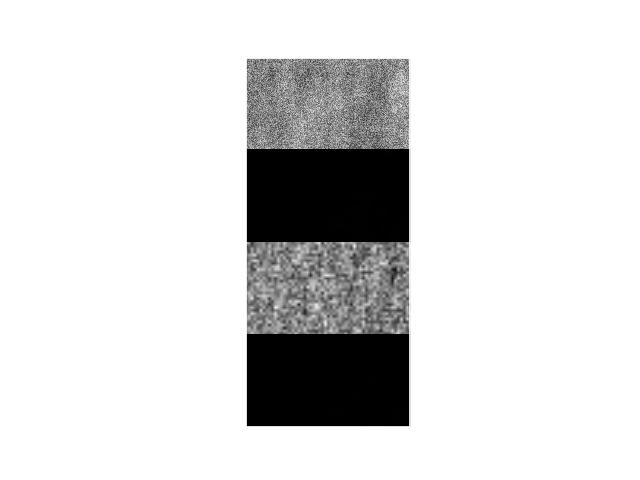
Example
>>> # xdoctest: +REQUIRES(module:kwcoco) >>> # Test case where requested channel does not exist >>> import kwcoco >>> from delayed_image.delayed_nodes import * # NOQA >>> dset = kwcoco.CocoDataset.demo('vidshapes8-multispectral', use_cache=1, verbose=100) >>> self = delayed = dset.coco_image(1).delay() >>> channels = 'B1|foobar|bazbiz|B8' >>> new = self.take_channels(channels) >>> new_cropped = new.crop((slice(10, 200), slice(12, 350))) >>> fused = new_cropped.finalize() >>> assert fused.shape == (190, 338, 4) >>> assert np.all(np.isnan(fused[..., 1:3])) >>> assert not np.any(np.isnan(fused[..., 0])) >>> assert not np.any(np.isnan(fused[..., 3]))
- property num_overviews¶
Returns: int
- undo_warps(remove=None, retain=None, squash_nans=False, return_warps=False)[source]¶
Attempts to “undo” warping for each concatenated channel and returns a list of delayed operations that are cropped to the right regions.
Typically you will retrain offset, theta, and shear to remove scale. This ensures the data is spatially aligned up to a scale factor.
- Parameters:
remove (List[str]) – if specified, list components of the warping to remove. Can include: “offset”, “scale”, “shearx”, “theta”. Typically set this to [“scale”].
retain (List[str]) – if specified, list components of the warping to retain. Can include: “offset”, “scale”, “shearx”, “theta”. Mutually exclusive with “remove”. If neither remove or retain is specified, retain is set to
[].squash_nans (bool) – if True, pure nan channels are squashed into a 1x1 array as they do not correspond to a real source.
return_warps (bool) – if True, return the transforms we applied. I.e. the transform from the
selfto the returnedparts. This is useful when you need to warp objects in the original space into the jagged space.
- Returns:
The List[DelayedImage] are the
partsi.e. the new images with the warping undone. The List[kwimage.Affine]: is the transforms fromselfto each item inparts- Return type:
List[DelayedImage] | Tuple[List[DelayedImage] | List[kwimage.Affine]]
Example
>>> from delayed_image.delayed_nodes import * # NOQA >>> from delayed_image.delayed_leafs import DelayedLoad >>> from delayed_image.delayed_leafs import DelayedNans >>> import ubelt as ub >>> import kwimage >>> import kwarray >>> import numpy as np >>> # Demo case where we have different channels at different resolutions >>> base = DelayedLoad.demo(channels='r|g|b').prepare().dequantize({'quant_max': 255}) >>> bandR = base[:, :, 0].scale(100 / 512)[:, :-50].evaluate() >>> bandG = base[:, :, 1].scale(300 / 512).warp({'theta': np.pi / 8, 'about': (150, 150)}).evaluate() >>> bandB = base[:, :, 2].scale(600 / 512)[:150, :].evaluate() >>> bandN = DelayedNans((600, 600), channels='N') >>> # Make a concatenation of images of different underlying native resolutions >>> delayed_vidspace = DelayedChannelConcat([ >>> bandR.scale(6, dsize=(600, 600)).optimize(), >>> bandG.warp({'theta': -np.pi / 8, 'about': (150, 150)}).scale(2, dsize=(600, 600)).optimize(), >>> bandB.scale(1, dsize=(600, 600)).optimize(), >>> bandN, >>> ]).warp({'scale': 0.7}).optimize() >>> vidspace_box = kwimage.Boxes([[100, 10, 270, 160]], 'ltrb') >>> vidspace_poly = vidspace_box.to_polygons()[0] >>> vidspace_slice = vidspace_box.to_slices()[0] >>> self = delayed_vidspace[vidspace_slice].optimize() >>> print('--- Aligned --- ') >>> self.write_network_text() >>> squash_nans = True >>> undone_all_parts, tfs1 = self.undo_warps(squash_nans=squash_nans, return_warps=True) >>> undone_scale_parts, tfs2 = self.undo_warps(remove=['scale'], squash_nans=squash_nans, return_warps=True) >>> stackable_aligned = self.finalize().transpose(2, 0, 1) >>> stackable_undone_all = [] >>> stackable_undone_scale = [] >>> print('--- Undone All --- ') >>> for undone in undone_all_parts: ... undone.write_network_text() ... stackable_undone_all.append(undone.finalize()) >>> print('--- Undone Scale --- ') >>> for undone in undone_scale_parts: ... undone.write_network_text() ... stackable_undone_scale.append(undone.finalize()) >>> # xdoctest: +REQUIRES(--show) >>> import kwplot >>> kwplot.autompl() >>> canvas0 = kwimage.stack_images(stackable_aligned, axis=1) >>> canvas1 = kwimage.stack_images(stackable_undone_all, axis=1) >>> canvas2 = kwimage.stack_images(stackable_undone_scale, axis=1) >>> canvas0 = kwimage.draw_header_text(canvas0, 'Rescaled Aligned Channels') >>> canvas1 = kwimage.draw_header_text(canvas1, 'Unwarped Channels') >>> canvas2 = kwimage.draw_header_text(canvas2, 'Unscaled Channels') >>> canvas = kwimage.stack_images([canvas0, canvas1, canvas2], axis=0) >>> canvas = kwimage.fill_nans_with_checkers(canvas) >>> kwplot.imshow(canvas)
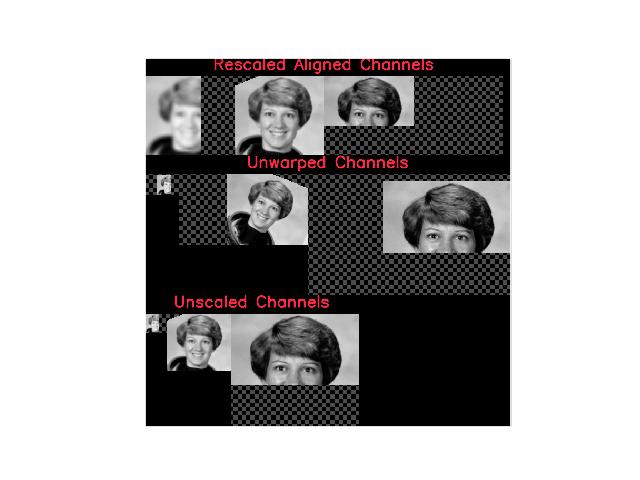
- class kwcoco.util.delayed_ops.DelayedConcat(parts, axis)[source]¶
Bases:
DelayedNaryOperationStacks multiple arrays together.
- Parameters:
parts (List[DelayedArray]) – data to concat
axis (int) – axes to concat on
- property shape¶
Returns: None | Tuple[int | None, …]
- class kwcoco.util.delayed_ops.DelayedCrop(subdata, space_slice=None, chan_idxs=None)[source]¶
Bases:
DelayedImageCrops an image along integer pixel coordinates.
Example
>>> from delayed_image.delayed_nodes import * # NOQA >>> from delayed_image import DelayedLoad >>> base = DelayedLoad.demo(dsize=(16, 16)).prepare() >>> # Test Fuse Crops Space Only >>> crop1 = base[4:12, 0:16] >>> self = crop1[2:6, 0:8] >>> opt = self._opt_fuse_crops() >>> self.write_network_text() >>> opt.write_network_text() >>> # >>> # Test Channel Select Via Index >>> self = base[:, :, [0]] >>> self.write_network_text() >>> final = self._finalize() >>> assert final.shape == (16, 16, 1) >>> assert base[:, :, [0, 1]].finalize().shape == (16, 16, 2) >>> assert base[:, :, [2, 0, 1]].finalize().shape == (16, 16, 3)
Example
>>> from delayed_image.delayed_nodes import * # NOQA >>> from delayed_image import DelayedLoad >>> base = DelayedLoad.demo(dsize=(16, 16)).prepare() >>> # Test Discontiguous Channel Select Via Index >>> self = base[:, :, [0, 2]] >>> self.write_network_text() >>> final = self._finalize() >>> assert final.shape == (16, 16, 2)
- Parameters:
subdata (DelayedArray) – data to operate on
space_slice (Tuple[slice, slice]) – if speficied, take this y-slice and x-slice.
chan_idxs (List[int] | None) – if specified, take these channels / bands
- optimize()[source]¶
- Returns:
DelayedImage
Example
>>> # Test optimize nans >>> from delayed_image import DelayedNans >>> import kwimage >>> base = DelayedNans(dsize=(100, 100), channels='a|b|c') >>> self = base[0:10, 0:5] >>> # Should simply return a new nan generator >>> new = self.optimize() >>> self.write_network_text() >>> new.write_network_text() >>> assert len(new.as_graph().nodes) == 1
- _opt_fuse_crops()[source]¶
Combine two consecutive crops into a single operation.
Example
>>> from delayed_image.delayed_nodes import * # NOQA >>> from delayed_image.delayed_leafs import DelayedLoad >>> base = DelayedLoad.demo(dsize=(16, 16)).prepare() >>> # Test Fuse Crops Space Only >>> crop1 = base[4:12, 0:16] >>> crop2 = self = crop1[2:6, 0:8] >>> opt = crop2._opt_fuse_crops() >>> self.write_network_text() >>> opt.write_network_text() >>> opt._validate() >>> self._validate()
Example
>>> # Test Fuse Crops Channels Only >>> from delayed_image.delayed_nodes import * # NOQA >>> from delayed_image.delayed_leafs import DelayedLoad >>> base = DelayedLoad.demo(dsize=(16, 16)).prepare() >>> crop1 = base.crop(chan_idxs=[0, 2, 1]) >>> crop2 = crop1.crop(chan_idxs=[1, 2]) >>> crop3 = self = crop2.crop(chan_idxs=[0, 1]) >>> opt = self._opt_fuse_crops()._opt_fuse_crops() >>> self.write_network_text() >>> opt.write_network_text() >>> finalB = base._validate()._finalize() >>> final1 = opt._validate()._finalize() >>> final2 = self._validate()._finalize() >>> assert np.all(final2[..., 0] == finalB[..., 2]) >>> assert np.all(final2[..., 1] == finalB[..., 1]) >>> assert np.all(final2[..., 0] == final1[..., 0]) >>> assert np.all(final2[..., 1] == final1[..., 1])
Example
>>> # Test Fuse Crops Space And Channels >>> from delayed_image.delayed_nodes import * # NOQA >>> from delayed_image.delayed_leafs import DelayedLoad >>> base = DelayedLoad.demo(dsize=(16, 16)).prepare() >>> crop1 = base[4:12, 0:16, [1, 2]] >>> self = crop1[2:6, 0:8, [1]] >>> opt = self._opt_fuse_crops() >>> self.write_network_text() >>> opt.write_network_text() >>> self._validate() >>> crop1._validate()
- _opt_warp_after_crop()[source]¶
If the child node is a warp, move it after the crop.
- This is more efficient because:
The crop is closer to the load.
we are warping with less data.
Example
>>> from delayed_image.delayed_nodes import * # NOQA >>> from delayed_image.delayed_leafs import DelayedLoad >>> fpath = kwimage.grab_test_image_fpath() >>> node0 = DelayedLoad(fpath, channels='r|g|b').prepare() >>> node1 = node0.warp({'scale': 0.432, >>> 'theta': np.pi / 3, >>> 'about': (80, 80), >>> 'shearx': .3, >>> 'offset': (-50, -50)}) >>> node2 = node1[10:50, 1:40] >>> self = node2 >>> new_outer = node2._opt_warp_after_crop() >>> print(ub.urepr(node2.nesting(), nl=-1, sort=0)) >>> print(ub.urepr(new_outer.nesting(), nl=-1, sort=0)) >>> final0 = self._finalize() >>> final1 = new_outer._finalize() >>> # xdoctest: +REQUIRES(--show) >>> import kwplot >>> kwplot.autompl() >>> kwplot.imshow(final0, pnum=(2, 2, 1), fnum=1, title='raw') >>> kwplot.imshow(final1, pnum=(2, 2, 2), fnum=1, title='optimized')
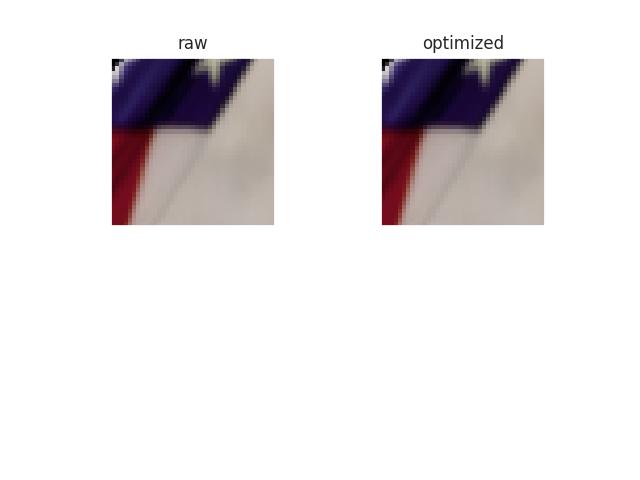
Example
>>> # xdoctest: +REQUIRES(module:osgeo) >>> from delayed_image import * # NOQA >>> from delayed_image.delayed_leafs import DelayedLoad >>> fpath = kwimage.grab_test_image_fpath(overviews=3) >>> node0 = DelayedLoad(fpath, channels='r|g|b').prepare() >>> node1 = node0.warp({'scale': 1000 / 512}) >>> node2 = node1[250:750, 0:500] >>> self = node2 >>> new_outer = node2._opt_warp_after_crop() >>> print(ub.urepr(node2.nesting(), nl=-1, sort=0)) >>> print(ub.urepr(new_outer.nesting(), nl=-1, sort=0))
- class kwcoco.util.delayed_ops.DelayedDequantize(subdata, quantization)[source]¶
Bases:
DelayedImageRescales image intensities from int to floats.
The output is usually between 0 and 1. This also handles transforming nodata into nan values.
- Parameters:
subdata (DelayedArray) – data to operate on
quantization (Dict) – see
delayed_image.helpers.dequantize()
- optimize()[source]¶
- Returns:
DelayedImage
Example
>>> # Test a case that caused an error in development >>> from delayed_image.delayed_nodes import * # NOQA >>> from delayed_image import DelayedLoad >>> fpath = kwimage.grab_test_image_fpath() >>> base = DelayedLoad(fpath, channels='r|g|b').prepare() >>> quantization = {'quant_max': 255, 'nodata': 0} >>> self = base.get_overview(1).dequantize(quantization) >>> self.write_network_text() >>> opt = self.optimize()
- class kwcoco.util.delayed_ops.DelayedFrameStack(parts)[source]¶
Bases:
DelayedStackStacks multiple arrays together.
- Parameters:
parts (List[DelayedArray]) – data to stack
- class kwcoco.util.delayed_ops.DelayedIdentity(data, channels=None, dsize=None)[source]¶
Bases:
DelayedImageLeafReturns an ndarray as-is
Example
self = DelayedNans((10, 10), channel_spec.FusedChannelSpec.coerce(‘rgb’)) region_slices = (slice(5, 10), slice(1, 12)) delayed = self.crop(region_slices)
Example
>>> from delayed_image import * # NOQA >>> arr = kwimage.checkerboard() >>> self = DelayedIdentity(arr, channels='gray') >>> warp = self.warp({'scale': 1.07}) >>> warp.optimize().finalize()
- class kwcoco.util.delayed_ops.DelayedImage(subdata=None, dsize=None, channels=None)[source]¶
Bases:
ImageOpsMixin,DelayedArrayFor the case where an array represents a 2D image with multiple channels
- Parameters:
subdata (DelayedArray)
dsize (None | Tuple[int | None, int | None]) – overrides subdata dsize
channels (None | int | FusedChannelSpec) – overrides subdata channels
- property shape¶
Returns: None | Tuple[int | None, int | None, int | None]
- property num_channels¶
Returns: None | int
- property dsize¶
Returns: None | Tuple[int | None, int | None]
- property channels¶
Returns: None | FusedChannelSpec
- property num_overviews¶
Returns: int
- take_channels(channels)[source]¶
This method returns a subset of the vision data with only the specified bands / channels.
- Parameters:
channels (List[int] | slice | channel_spec.FusedChannelSpec) – List of integers indexes, a slice, or a channel spec, which is typically a pipe (|) delimited list of channel codes. See ChannelSpec for more detials.
- Returns:
a new delayed load with a fused take channel operation
- Return type:
Note
The channel subset must exist here or it will raise an error. A better implementation (via pymbolic) might be able to do better
Example
>>> # >>> # Test Channel Select Via Code >>> from delayed_image.delayed_nodes import * # NOQA >>> from delayed_image import DelayedLoad >>> self = DelayedLoad.demo(dsize=(16, 16), channels='r|g|b').prepare() >>> channels = 'r|b' >>> new = self.take_channels(channels)._validate() >>> new2 = new[:, :, [1, 0]]._validate() >>> new3 = new2[:, :, [1]]._validate()
Example
>>> from delayed_image.delayed_nodes import * # NOQA >>> from delayed_image import DelayedLoad >>> self = DelayedLoad.demo('astro').prepare() >>> channels = [2, 0] >>> new = self.take_channels(channels) >>> new3 = new.take_channels([1, 0]) >>> new._validate() >>> new3._validate()
>>> final1 = self.finalize() >>> final2 = new.finalize() >>> final3 = new3.finalize() >>> assert np.all(final1[..., 2] == final2[..., 0]) >>> assert np.all(final1[..., 0] == final2[..., 1]) >>> assert final2.shape[2] == 2
>>> assert np.all(final1[..., 2] == final3[..., 1]) >>> assert np.all(final1[..., 0] == final3[..., 0]) >>> assert final3.shape[2] == 2
Example
>>> from delayed_image.delayed_nodes import * # NOQA >>> from delayed_image import DelayedLoad >>> self = DelayedLoad.demo(dsize=(16, 16), channels='r|g|b').prepare() >>> # Case where a channel doesn't exist >>> channels = 'r|b|magic' >>> new = self.take_channels(channels) >>> assert len(new.parts) == 2 >>> new._validate()
- _opt_push_under_concat()[source]¶
Push this node under its child node if it is a concatenation operation
- undo_warp(remove=None, retain=None, squash_nans=False, return_warp=False)[source]¶
Attempts to “undo” warping for each concatenated channel and returns a list of delayed operations that are cropped to the right regions.
Typically you will retrain offset, theta, and shear to remove scale. This ensures the data is spatially aligned up to a scale factor.
- Parameters:
remove (List[str]) – if specified, list components of the warping to remove. Can include: “offset”, “scale”, “shearx”, “theta”. Typically set this to [“scale”].
retain (List[str]) – if specified, list components of the warping to retain. Can include: “offset”, “scale”, “shearx”, “theta”. Mutually exclusive with “remove”. If neither remove or retain is specified, retain is set to
[].squash_nans (bool) – if True, pure nan channels are squashed into a 1x1 array as they do not correspond to a real source.
return_warp (bool) – if True, return the transform we applied. This is useful when you need to warp objects in the original space into the jagged space.
- SeeAlso:
DelayedChannelConcat.undo_warps
Example
>>> # Test similar to undo_warps, but on each channel separately >>> from delayed_image.delayed_nodes import * # NOQA >>> from delayed_image.delayed_leafs import DelayedLoad >>> from delayed_image.delayed_leafs import DelayedNans >>> import ubelt as ub >>> import kwimage >>> import kwarray >>> import numpy as np >>> # Demo case where we have different channels at different resolutions >>> base = DelayedLoad.demo(channels='r|g|b').prepare().dequantize({'quant_max': 255}) >>> bandR = base[:, :, 0].scale(100 / 512)[:, :-50].evaluate() >>> bandG = base[:, :, 1].scale(300 / 512).warp({'theta': np.pi / 8, 'about': (150, 150)}).evaluate() >>> bandB = base[:, :, 2].scale(600 / 512)[:150, :].evaluate() >>> bandN = DelayedNans((600, 600), channels='N') >>> B0 = bandR.scale(6, dsize=(600, 600)).optimize() >>> B1 = bandG.warp({'theta': -np.pi / 8, 'about': (150, 150)}).scale(2, dsize=(600, 600)).optimize() >>> B2 = bandB.scale(1, dsize=(600, 600)).optimize() >>> vidspace_box = kwimage.Boxes([[-10, -10, 270, 160]], 'ltrb').scale(1 / .7).quantize() >>> vidspace_poly = vidspace_box.to_polygons()[0] >>> vidspace_slice = vidspace_box.to_slices()[0] >>> # Test with the padded crop >>> self0 = B0.crop(vidspace_slice, wrap=0, clip=0, pad=10).optimize() >>> self1 = B1.crop(vidspace_slice, wrap=0, clip=0, pad=10).optimize() >>> self2 = B2.crop(vidspace_slice, wrap=0, clip=0, pad=10).optimize() >>> parts = [self0, self1, self2] >>> # Run the undo on each channel >>> undone_scale_parts = [d.undo_warp(remove=['scale']) for d in parts] >>> print('--- Aligned --- ') >>> stackable_aligned = [] >>> for d in parts: >>> d.write_network_text() >>> stackable_aligned.append(d.finalize()) >>> print('--- Undone Scale --- ') >>> stackable_undone_scale = [] >>> for undone in undone_scale_parts: ... undone.write_network_text() ... stackable_undone_scale.append(undone.finalize()) >>> # xdoctest: +REQUIRES(--show) >>> import kwplot >>> kwplot.autompl() >>> canvas0 = kwimage.stack_images(stackable_aligned, axis=1, pad=5, bg_value='kw_darkgray') >>> canvas2 = kwimage.stack_images(stackable_undone_scale, axis=1, pad=5, bg_value='kw_darkgray') >>> canvas0 = kwimage.draw_header_text(canvas0, 'Rescaled Channels') >>> canvas2 = kwimage.draw_header_text(canvas2, 'Native Scale Channels') >>> canvas = kwimage.stack_images([canvas0, canvas2], axis=0, bg_value='kw_darkgray') >>> canvas = kwimage.fill_nans_with_checkers(canvas) >>> kwplot.imshow(canvas)
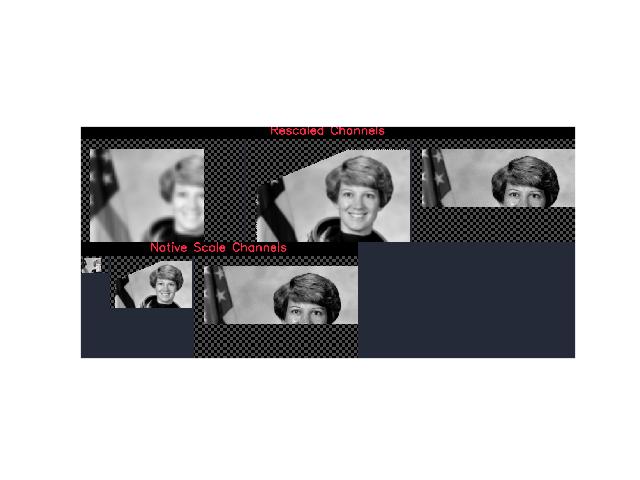
- class kwcoco.util.delayed_ops.DelayedImageLeaf(subdata=None, dsize=None, channels=None)[source]¶
Bases:
DelayedImage- Parameters:
subdata (DelayedArray)
dsize (None | Tuple[int | None, int | None]) – overrides subdata dsize
channels (None | int | FusedChannelSpec) – overrides subdata channels
- class kwcoco.util.delayed_ops.DelayedLoad(fpath, channels=None, dsize=None, nodata_method=None)[source]¶
Bases:
DelayedImageLeafPoints to an image on disk to be loaded.
This is the starting point for most delayed operations. Disk IO is avoided until the
finalizeoperation is called. Callingpreparecan read image headers if metadata like the image width, height, and number of channels is not provided, but most operations can be performed while these are still unknown.If a gdal backend is available, and the underlying image is in the appropriate formate (e.g. COG), finalize will return a lazy reference that enables fast overviews and crops. For image formats that do not allow for tiling / overviews, then there is no way to avoid reading entire image as an ndarray.
Example
>>> from delayed_image import * # NOQA >>> self = DelayedLoad.demo(dsize=(16, 16)).prepare() >>> data1 = self.finalize()
Example
>>> # xdoctest: +REQUIRES(module:osgeo) >>> # Demo code to develop support for overviews >>> from delayed_image import * # NOQA >>> import kwimage >>> import ubelt as ub >>> fpath = kwimage.grab_test_image_fpath(overviews=3) >>> self = DelayedLoad(fpath, channels='r|g|b').prepare() >>> print(f'self={self}') >>> print('self.meta = {}'.format(ub.repr2(self.meta, nl=1))) >>> quantization = { >>> 'quant_max': 255, >>> 'nodata': 0, >>> } >>> node0 = self >>> node1 = node0.get_overview(2) >>> node2 = node1[13:900, 11:700] >>> node3 = node2.dequantize(quantization) >>> node4 = node3.warp({'scale': 0.05}) >>> # >>> data0 = node0._validate().finalize() >>> data1 = node1._validate().finalize() >>> data2 = node2._validate().finalize() >>> data3 = node3._validate().finalize() >>> data4 = node4._validate().finalize() >>> node4.write_network_text()
Example
>>> # xdoctest: +REQUIRES(module:osgeo) >>> # Test delayed ops with int16 and nodata values >>> from delayed_image import * # NOQA >>> import kwimage >>> from delayed_image.helpers import quantize_float01 >>> import ubelt as ub >>> dpath = ub.Path.appdir('delayed_image/tests/test_delay_nodata').ensuredir() >>> fpath = dpath / 'data.tif' >>> data = kwimage.ensure_float01(kwimage.grab_test_image()) >>> poly = kwimage.Polygon.random(rng=321032).scale(data.shape[0]) >>> poly.fill(data, np.nan) >>> data_uint16, quantization = quantize_float01(data) >>> nodata = quantization['nodata'] >>> kwimage.imwrite(fpath, data_uint16, nodata=nodata, backend='gdal', overviews=3) >>> # Test loading the data >>> self = DelayedLoad(fpath, channels='r|g|b', nodata_method='float').prepare() >>> node0 = self >>> node1 = node0.dequantize(quantization) >>> node2 = node1.warp({'scale': 0.51}, interpolation='lanczos') >>> node3 = node2[13:900, 11:700] >>> node4 = node3.warp({'scale': 0.9}, interpolation='lanczos') >>> node4.write_network_text() >>> node5 = node4.optimize() >>> node5.write_network_text() >>> node6 = node5.warp({'scale': 8}, interpolation='lanczos').optimize() >>> node6.write_network_text() >>> # >>> data0 = node0._validate().finalize() >>> data1 = node1._validate().finalize() >>> data2 = node2._validate().finalize() >>> data3 = node3._validate().finalize() >>> data4 = node4._validate().finalize() >>> data5 = node5._validate().finalize() >>> data6 = node6._validate().finalize() >>> # xdoctest: +REQUIRES(--show) >>> import kwplot >>> kwplot.autompl() >>> stack1 = kwimage.stack_images([data1, data2, data3, data4, data5]) >>> stack2 = kwimage.stack_images([stack1, data6], axis=1) >>> kwplot.imshow(stack2)
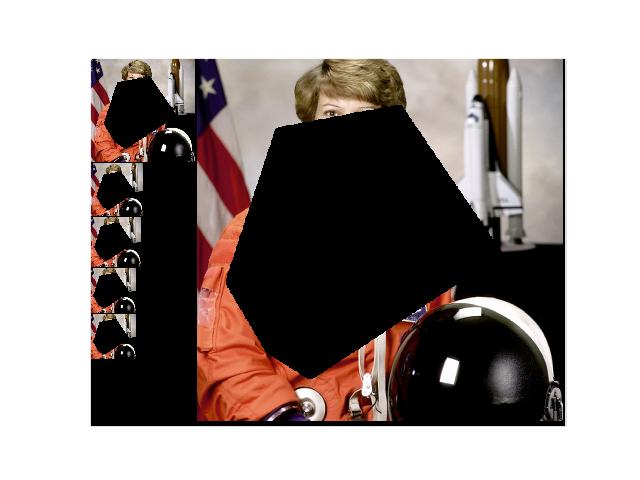
- Parameters:
fpath (str | PathLike) – URI pointing at the image data to load
channels (int | str | FusedChannelSpec | None) – the underlying channels of the image if known a-priori
dsize (Tuple[int, int]) – The width / height of the image if known a-priori
nodata_method (str | None) – How to handle nodata values in the file itself. Can be “auto”, “float”, or “ma”.
- property fpath¶
- classmethod demo(key='astro', channels=None, dsize=None, nodata_method=None, overviews=None)[source]¶
Creates a demo DelayedLoad node that points to a file generated by
kwimage.grab_test_image_fpath().If metadata like dsize and channels are not provided, then the
prepare()can be used to auto-populate them at the cost of the disk IO to read image headers.- Parameters:
key (str) – which test image to grab. Valid choices are: astro - an astronaught carl - Carl Sagan paraview - ParaView logo stars - picture of stars in the sky
channels (str) – if specified, these channels will be stored in the delayed load metadata. Note: these are not auto-populated. Usually the key corresponds to 3-channel data,
dsize (None | Tuple[int, int]) – if specified, we will return a variant of the data with the specific dsize
nodata_method (str | None) – How to handle nodata values in the file itself. Can be “auto”, “float”, or “ma”.
overviews (None | int) – if specified, will return a variant of the data with overviews
- Returns:
DelayedLoad
Example
>>> from delayed_image.delayed_leafs import * # NOQA >>> import delayed_image >>> delayed = delayed_image.DelayedLoad.demo() >>> print(f'delayed={delayed}') >>> delayed.prepare() >>> print(f'delayed={delayed}') >>> delayed = DelayedLoad.demo(channels='r|g|b', nodata_method='float') >>> print(f'delayed={delayed}') >>> delayed.prepare() >>> print(f'delayed={delayed}') >>> delayed.finalize()
- prepare()[source]¶
If metadata is missing, perform minimal IO operations in order to prepopulate metadata that could help us better optimize the operation tree.
- Returns:
DelayedLoad
- _finalize()[source]¶
- Returns:
ArrayLike
Example
>>> # Check difference between finalize and _finalize >>> from delayed_image.delayed_leafs import * # NOQA >>> self = DelayedLoad.demo().prepare() >>> final_arr = self.finalize() >>> assert isinstance(final_arr, np.ndarray), 'finalize should always return an array' >>> final_ref = self._finalize() >>> if self.lazy_ref is not NotImplemented: >>> assert not isinstance(final_ref, np.ndarray), ( >>> 'A pure load with gdal should return a reference that is ' >>> 'similiar to but not quite an array')
- class kwcoco.util.delayed_ops.DelayedNans(dsize=None, channels=None)[source]¶
Bases:
DelayedImageLeafConstructs nan channels as needed
Example
self = DelayedNans((10, 10), channel_spec.FusedChannelSpec.coerce(‘rgb’)) region_slices = (slice(5, 10), slice(1, 12)) delayed = self.crop(region_slices)
Example
>>> from delayed_image.delayed_leafs import * # NOQA >>> from delayed_image import DelayedChannelConcat >>> dsize = (307, 311) >>> c1 = DelayedNans(dsize=dsize, channels='foo') >>> c2 = DelayedLoad.demo('astro', dsize=dsize, channels='R|G|B').prepare() >>> cat = DelayedChannelConcat([c1, c2]) >>> warped_cat = cat.warp({'scale': 1.07}, dsize=(328, 332))._validate() >>> warped_cat._validate().optimize().finalize()
- class kwcoco.util.delayed_ops.DelayedNaryOperation(parts)[source]¶
Bases:
DelayedOperationFor operations that have multiple input arrays
- class kwcoco.util.delayed_ops.DelayedOperation[source]¶
Bases:
NiceRepr- as_graph(fields='auto')[source]¶
Builds the underlying graph structure as a networkx graph with human readable labels.
- Parameters:
fields (str | List[str]) – Add the specified fields as labels. If ‘auto’ then does somthing “reasonable”. If ‘all’ then shows everything. TODO: only implemented for “auto” and “all”, implement general field selection (PR Wanted).
- Returns:
networkx.DiGraph
- _traverse()[source]¶
A flat list of all descendent nodes and their parents
- Yields:
Tuple[None | DelayedOperation, DelayedOperation] – tules of parent / child nodes. Discarding the parents will be a list of all nodes.
- _leafs()¶
Iterates over all leafs in the tree.
- Yields:
Tuple[DelayedOperation]
- _leaf_paths()[source]¶
Builds all independent paths to leafs.
- Yields:
Tuple[DelayedOperation, DelayedOperation] – The leaf, and the path to it,
Example
>>> from delayed_image import demo >>> self = demo.non_aligned_leafs() >>> for leaf, part in list(self._leaf_paths()): ... leaf.write_network_text() ... part.write_network_text()
Example
>>> from delayed_image import demo >>> import delayed_image >>> orig = delayed_image.DelayedLoad.demo().prepare() >>> part1 = orig[0:100, 0:100].scale(2, dsize=(128, 128)) >>> part2 = delayed_image.DelayedNans(dsize=(128, 128)) >>> self = delayed_image.DelayedChannelConcat([part2, part1]) >>> for leaf, part in list(self._leaf_paths()): ... leaf.write_network_text() ... part.write_network_text()
- print_graph(fields='auto', with_labels=True, rich='auto', vertical_chains=True)[source]¶
Alias for write_network_text
- Parameters:
fields (str | List[str]) – Add the specified fields as labels. If ‘auto’ then does somthing “reasonable”. If ‘all’ then shows everything. TODO: only implemented for “auto” and “all”, implement general field selection (PR Wanted).
with_labels (bool) – set to false for no label data
rich (bool | str) – defaults to ‘auto’
vertical_chains (bool) – Defaults to True. Set to false to save vertical space at the cost of horizontal space.
- write_network_text(fields='auto', with_labels=True, rich='auto', vertical_chains=True)[source]¶
Alias for
DelayedOperation.print_graph()
- property shape¶
Returns: None | Tuple[int | None, …]
- prepare()[source]¶
If metadata is missing, perform minimal IO operations in order to prepopulate metadata that could help us better optimize the operation tree.
- Returns:
DelayedOperation
- _finalize()[source]¶
This is the method that new nodes should overload.
Conceptually this works just like the finalize method with the exception that it happens at every node in the tree, whereas the public facing method only happens once, calls this, and is able to do one-time pre and post operations.
- Returns:
ArrayLike
- finalize(prepare=True, optimize=True, **kwargs)[source]¶
Evaluate the operation tree in full.
- Parameters:
prepare (bool) – ensure prepare is called to ensure metadata exists if possible before optimizing. Defaults to True.
optimize (bool) – ensure the graph is optimized before loading. Default to True.
**kwargs – for backwards compatibility, these will allow for in-place modification of select nested parameters.
- Returns:
ArrayLike
Notes
Do not overload this method. Overload
DelayedOperation._finalize()instead.
- class kwcoco.util.delayed_ops.DelayedOverview(subdata, overview)[source]¶
Bases:
DelayedImageDownsamples an image by a factor of two.
If the underlying image being loaded has precomputed overviews it simply loads these instead of downsampling the original image, which is more efficient.
Example
>>> # xdoctest: +REQUIRES(module:osgeo) >>> # Make a complex chain of operations and optimize it >>> from delayed_image import * # NOQA >>> import kwimage >>> fpath = kwimage.grab_test_image_fpath(overviews=3) >>> dimg = DelayedLoad(fpath, channels='r|g|b').prepare() >>> dimg = dimg.get_overview(1) >>> dimg = dimg.get_overview(1) >>> dimg = dimg.get_overview(1) >>> dopt = dimg.optimize() >>> if 1: >>> import networkx as nx >>> dimg.write_network_text() >>> dopt.write_network_text() >>> print(ub.urepr(dopt.nesting(), nl=-1, sort=0)) >>> final0 = dimg._finalize()[:] >>> final1 = dopt._finalize()[:] >>> assert final0.shape == final1.shape >>> # xdoctest: +REQUIRES(--show) >>> import kwplot >>> kwplot.autompl() >>> kwplot.imshow(final0, pnum=(1, 2, 1), fnum=1, title='raw') >>> kwplot.imshow(final1, pnum=(1, 2, 2), fnum=1, title='optimized')
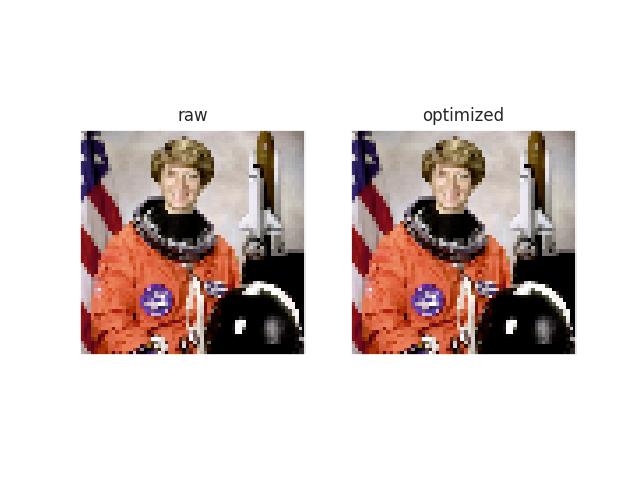
- Parameters:
subdata (DelayedArray) – data to operate on
overview (int) – the overview to use (assuming it exists)
- property num_overviews¶
Returns: int
- _opt_overview_as_warp()[source]¶
Sometimes it is beneficial to replace an overview with a warp as an intermediate optimization step.
- _opt_crop_after_overview()[source]¶
Given an outer overview and an inner crop, switch places. We want the overview to be as close to the load as possible.
Example
>>> # xdoctest: +REQUIRES(module:osgeo) >>> from delayed_image import * # NOQA >>> fpath = kwimage.grab_test_image_fpath(overviews=3) >>> node0 = DelayedLoad(fpath, channels='r|g|b').prepare() >>> node1 = node0[100:400, 120:450] >>> node2 = node1.get_overview(2) >>> self = node2 >>> new_outer = node2.optimize() >>> print(ub.urepr(node2.nesting(), nl=-1, sort=0)) >>> print(ub.urepr(new_outer.nesting(), nl=-1, sort=0)) >>> final0 = self._finalize() >>> final1 = new_outer._finalize() >>> # xdoctest: +REQUIRES(--show) >>> import kwplot >>> kwplot.autompl() >>> kwplot.imshow(final0, pnum=(1, 2, 1), fnum=1, title='raw') >>> kwplot.imshow(final1, pnum=(1, 2, 2), fnum=1, title='optimized')
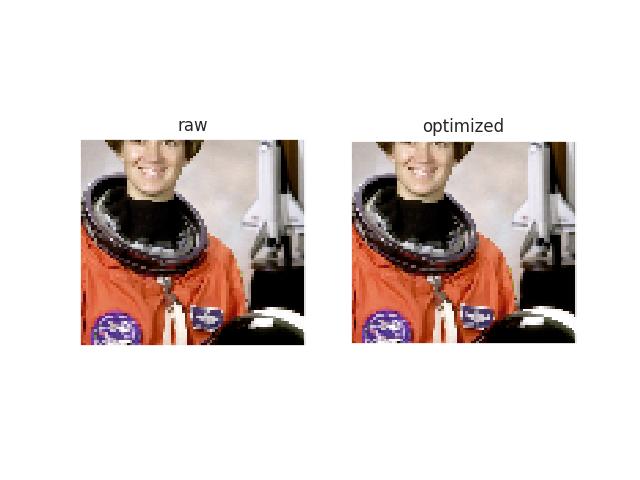
Example
>>> # xdoctest: +REQUIRES(module:osgeo) >>> from delayed_image import * # NOQA >>> fpath = kwimage.grab_test_image_fpath(overviews=3) >>> node0 = DelayedLoad(fpath, channels='r|g|b').prepare() >>> node1 = node0[:, :, 0:2] >>> node2 = node1.get_overview(2) >>> self = node2 >>> new_outer = node2.optimize() >>> node2.write_network_text() >>> new_outer.write_network_text() >>> assert node2.shape[2] == 2 >>> assert new_outer.shape[2] == 2
- _opt_warp_after_overview()[source]¶
Given an warp followed by an overview, move the warp to the outer scope such that the overview is first.
Example
>>> # xdoctest: +REQUIRES(module:osgeo) >>> from delayed_image import * # NOQA >>> fpath = kwimage.grab_test_image_fpath(overviews=3) >>> node0 = DelayedLoad(fpath, channels='r|g|b').prepare() >>> node1 = node0.warp({'scale': (2.1, .7), 'offset': (20, 40)}) >>> node2 = node1.get_overview(2) >>> self = node2 >>> new_outer = node2.optimize() >>> print(ub.urepr(node2.nesting(), nl=-1, sort=0)) >>> print(ub.urepr(new_outer.nesting(), nl=-1, sort=0)) >>> final0 = self._finalize() >>> final1 = new_outer._finalize() >>> # xdoctest: +REQUIRES(--show) >>> import kwplot >>> kwplot.autompl() >>> kwplot.imshow(final0, pnum=(1, 2, 1), fnum=1, title='raw') >>> kwplot.imshow(final1, pnum=(1, 2, 2), fnum=1, title='optimized')

- class kwcoco.util.delayed_ops.DelayedStack(parts, axis)[source]¶
Bases:
DelayedNaryOperationStacks multiple arrays together.
- Parameters:
parts (List[DelayedArray]) – data to stack
axis (int) – axes to stack on
- property shape¶
Returns: None | Tuple[int | None, …]
- class kwcoco.util.delayed_ops.DelayedUnaryOperation(subdata)[source]¶
Bases:
DelayedOperationFor operations that have a single input array
- class kwcoco.util.delayed_ops.DelayedWarp(subdata, transform, dsize='auto', antialias=True, interpolation='linear', border_value='auto', noop_eps=0)[source]¶
Bases:
DelayedImageApplies an affine transform to an image.
Example
>>> from delayed_image.delayed_nodes import * # NOQA >>> from delayed_image import DelayedLoad >>> self = DelayedLoad.demo(dsize=(16, 16)).prepare() >>> warp1 = self.warp({'scale': 3}) >>> warp2 = warp1.warp({'theta': 0.1}) >>> warp3 = warp2._opt_fuse_warps() >>> warp3._validate() >>> print(ub.urepr(warp2.nesting(), nl=-1, sort=0)) >>> print(ub.urepr(warp3.nesting(), nl=-1, sort=0))
- Parameters:
subdata (DelayedArray) – data to operate on
transform (ndarray | dict | kwimage.Affine) – a coercable affine matrix. See
kwimage.Affinefor details on what can be coerced.dsize (Tuple[int, int] | str) – The width / height of the output canvas. If ‘auto’, dsize is computed such that the positive coordinates of the warped image will fit in the new canvas. In this case, any pixel that maps to a negative coordinate will be clipped. This has the property that the input transformation is not modified.
antialias (bool) – if True determines if the transform is downsampling and applies antialiasing via gaussian a blur. Defaults to False
interpolation (str) – interpolation code or cv2 integer. Interpolation codes are linear, nearest, cubic, lancsoz, and area. Defaults to “linear”.
noop_eps (float) – This is the tolerance for optimizing a warp away. If the transform has all of its decomposed parameters (i.e. scale, rotation, translation, shear) less than this value, the warp node can be optimized away. Defaults to 0.
- property transform¶
Returns: kwimage.Affine
- optimize()[source]¶
- Returns:
DelayedImage
Example
>>> # Demo optimization that removes a noop warp >>> from delayed_image import DelayedLoad >>> import kwimage >>> base = DelayedLoad.demo(channels='r|g|b').prepare() >>> self = base.warp(kwimage.Affine.eye()) >>> new = self.optimize() >>> assert len(self.as_graph().nodes) == 2 >>> assert len(new.as_graph().nodes) == 1
Example
>>> # Test optimize nans >>> from delayed_image import DelayedNans >>> import kwimage >>> base = DelayedNans(dsize=(100, 100), channels='a|b|c') >>> self = base.warp(kwimage.Affine.scale(0.1)) >>> # Should simply return a new nan generator >>> new = self.optimize() >>> assert len(new.as_graph().nodes) == 1
Example
>>> # Test optimize nans >>> from delayed_image import DelayedLoad >>> import kwimage >>> base = DelayedLoad.demo(channels='r|g|b').prepare() >>> transform = kwimage.Affine.scale(1.0 + 1e-7) >>> self = base.warp(transform, dsize=base.dsize) >>> # An optimize will not remove a warp if there is any >>> # doubt if it is the identity. >>> new = self.optimize() >>> assert len(self.as_graph().nodes) == 2 >>> assert len(new.as_graph().nodes) == 2 >>> # But we can specify a threshold where it will >>> self._set_nested_params(noop_eps=1e-6) >>> new = self.optimize() >>> assert len(self.as_graph().nodes) == 2 >>> assert len(new.as_graph().nodes) == 1
- _opt_absorb_overview()[source]¶
Remove any deeper overviews that would be undone by this warp.
Given this warp node, if it has a scale component could undo an overview (i.e. the scale factor is greater than 2), we want to:
determine if there is an overview deeper in the tree.
remove that overview and that scale factor from this warp
modify any intermediate nodes that will be changed by having the deeper overview removed.
Note
This optimization is currently the most dubious one in the code, and is likely where some of the bugs are coming from. Help wanted.
CommandLine
xdoctest -m delayed_image.delayed_nodes DelayedWarp._opt_absorb_overview
Example
>>> # xdoctest: +REQUIRES(module:osgeo) >>> from delayed_image.delayed_nodes import * # NOQA >>> from delayed_image import DelayedLoad >>> import kwimage >>> fpath = kwimage.grab_test_image_fpath(overviews=3) >>> base = DelayedLoad(fpath, channels='r|g|b').prepare() >>> # Case without any operations between the overview and warp >>> self = base.get_overview(1).warp({'scale': 4}) >>> self.write_network_text() >>> opt = self._opt_absorb_overview()._validate() >>> opt.write_network_text() >>> opt_data = [d for n, d in opt.as_graph().nodes(data=True)] >>> assert 'DelayedOverview' not in [d['type'] for d in opt_data] >>> # Case with a chain of operations between overview and warp >>> self = base.get_overview(1)[0:101, 0:100].warp({'scale': 4}) >>> self.write_network_text() >>> opt = self._opt_absorb_overview()._validate() >>> opt.write_network_text() >>> opt_data = [d for n, d in opt.as_graph().nodes(data=True)] >>> #assert opt_data[1]['meta']['space_slice'] == (slice(0, 202, None), slice(0, 200, None)) >>> assert opt_data[1]['meta']['space_slice'] == (slice(0, 204, None), slice(0, 202, None)) >>> # Any sort of complex chain does prevents this optimization >>> # from running. >>> self = base.get_overview(1)[0:101, 0:100][0:50, 0:50].warp({'scale': 4}) >>> opt = self._opt_absorb_overview()._validate() >>> opt.write_network_text() >>> opt_data = [d for n, d in opt.as_graph().nodes(data=True)] >>> assert 'DelayedOverview' in [d['type'] for d in opt_data]
- _opt_split_warp_overview()[source]¶
Split this node into a warp and an overview if possible
Example
>>> # xdoctest: +REQUIRES(module:osgeo) >>> from delayed_image.delayed_nodes import * # NOQA >>> from delayed_image import DelayedLoad >>> import kwimage >>> fpath = kwimage.grab_test_image_fpath(overviews=3) >>> self = DelayedLoad(fpath, channels='r|g|b').prepare() >>> print(f'self={self}') >>> print('self.meta = {}'.format(ub.urepr(self.meta, nl=1))) >>> warp0 = self.warp({'scale': 0.2}) >>> warp1 = warp0._opt_split_warp_overview() >>> warp2 = self.warp({'scale': 0.25})._opt_split_warp_overview() >>> print(ub.urepr(warp0.nesting(), nl=-1, sort=0)) >>> print(ub.urepr(warp1.nesting(), nl=-1, sort=0)) >>> print(ub.urepr(warp2.nesting(), nl=-1, sort=0)) >>> warp0_nodes = [d['type'] for d in warp0.as_graph().nodes.values()] >>> warp1_nodes = [d['type'] for d in warp1.as_graph().nodes.values()] >>> warp2_nodes = [d['type'] for d in warp2.as_graph().nodes.values()] >>> assert warp0_nodes == ['DelayedWarp', 'DelayedLoad'] >>> assert warp1_nodes == ['DelayedWarp', 'DelayedOverview', 'DelayedLoad'] >>> assert warp2_nodes == ['DelayedOverview', 'DelayedLoad']
Example
>>> # xdoctest: +REQUIRES(module:osgeo) >>> from delayed_image.delayed_nodes import * # NOQA >>> from delayed_image import DelayedLoad >>> import kwimage >>> fpath = kwimage.grab_test_image_fpath(overviews=3) >>> self = DelayedLoad(fpath, channels='r|g|b').prepare() >>> warp0 = self.warp({'scale': 1 / 2 ** 6}) >>> opt = warp0.optimize() >>> print(ub.urepr(warp0.nesting(), nl=-1, sort=0)) >>> print(ub.urepr(opt.nesting(), nl=-1, sort=0)) >>> warp0_nodes = [d['type'] for d in warp0.as_graph().nodes.values()] >>> opt_nodes = [d['type'] for d in opt.as_graph().nodes.values()] >>> assert warp0_nodes == ['DelayedWarp', 'DelayedLoad'] >>> assert opt_nodes == ['DelayedWarp', 'DelayedOverview', 'DelayedLoad']
- class kwcoco.util.delayed_ops.ImageOpsMixin[source]¶
Bases:
object- crop(space_slice=None, chan_idxs=None, clip=True, wrap=True, pad=0)[source]¶
Crops an image along integer pixel coordinates.
- Parameters:
space_slice (Tuple[slice, slice]) – y-slice and x-slice.
chan_idxs (List[int]) – indexes of bands to take
clip (bool) – if True, the slice is interpreted normally, where it won’t go past the image extent, otherwise slicing into negative regions or past the image bounds will result in padding. Defaults to True.
wrap (bool) – if True, negative indexes “wrap around”, otherwise they are treated as is. Defaults to True.
pad (int | List[Tuple[int, int]]) – if specified, applies extra padding
- Returns:
DelayedImage
Example
>>> from delayed_image import DelayedLoad >>> import kwimage >>> self = DelayedLoad.demo().prepare() >>> self = self.dequantize({'quant_max': 255}) >>> self = self.warp({'scale': 1 / 2}) >>> pad = 0 >>> h, w = space_dims = self.dsize[::-1] >>> grid = list(ub.named_product({ >>> 'left': [0, -64], 'right': [0, 64], >>> 'top': [0, -64], 'bot': [0, 64],})) >>> grid += [ >>> {'left': 64, 'right': -64, 'top': 0, 'bot': 0}, >>> {'left': 64, 'right': 64, 'top': 0, 'bot': 0}, >>> {'left': 0, 'right': 0, 'top': 64, 'bot': -64}, >>> {'left': 64, 'right': -64, 'top': 64, 'bot': -64}, >>> ] >>> crops = [] >>> for pads in grid: >>> space_slice = (slice(pads['top'], h + pads['bot']), >>> slice(pads['left'], w + pads['right'])) >>> delayed = self.crop(space_slice) >>> crop = delayed.finalize() >>> yyxx = kwimage.Boxes.from_slice(space_slice, wrap=False, clip=0).toformat('_yyxx').data[0] >>> title = '[{}:{}, {}:{}]'.format(*yyxx) >>> crop_canvas = kwimage.draw_header_text(crop, title, fit=True, bg_color='kw_darkgray') >>> crops.append(crop_canvas) >>> # xdoctest: +REQUIRES(--show) >>> import kwplot >>> kwplot.autompl() >>> canvas = kwimage.stack_images_grid(crops, pad=16, bg_value='kw_darkgreen') >>> canvas = kwimage.fill_nans_with_checkers(canvas) >>> kwplot.imshow(canvas, title='Normal Slicing: Cropped Images With Wrap+Clipped Slices', doclf=1, fnum=1) >>> kwplot.show_if_requested()
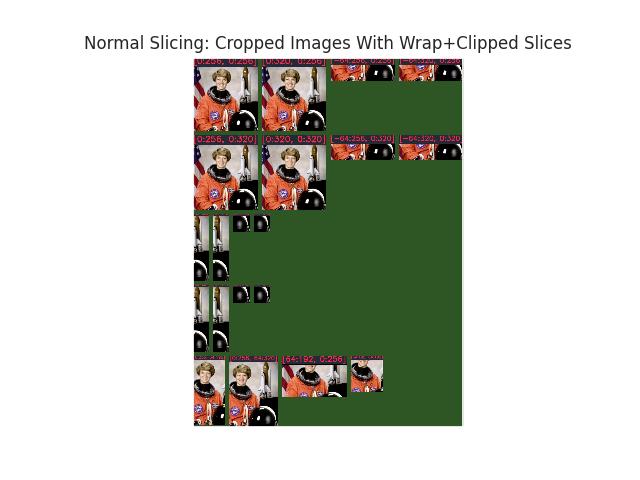
Example
>>> # Demo the case with pads / no-clips / no-wraps >>> from delayed_image import DelayedLoad >>> import kwimage >>> self = DelayedLoad.demo().prepare() >>> self = self.dequantize({'quant_max': 255}) >>> self = self.warp({'scale': 1 / 2}) >>> pad = [(64, 128), (32, 96)] >>> pad = [(0, 20), (0, 0)] >>> pad = 0 >>> pad = 8 >>> h, w = space_dims = self.dsize[::-1] >>> grid = list(ub.named_product({ >>> 'left': [0, -64], 'right': [0, 64], >>> 'top': [0, -64], 'bot': [0, 64],})) >>> grid += [ >>> {'left': 64, 'right': -64, 'top': 0, 'bot': 0}, >>> {'left': 64, 'right': 64, 'top': 0, 'bot': 0}, >>> {'left': 0, 'right': 0, 'top': 64, 'bot': -64}, >>> {'left': 64, 'right': -64, 'top': 64, 'bot': -64}, >>> ] >>> crops = [] >>> for pads in grid: >>> space_slice = (slice(pads['top'], h + pads['bot']), >>> slice(pads['left'], w + pads['right'])) >>> delayed = self._padded_crop(space_slice, pad=pad) >>> crop = delayed.finalize(optimize=1) >>> yyxx = kwimage.Boxes.from_slice(space_slice, wrap=False, clip=0).toformat('_yyxx').data[0] >>> title = '[{}:{}, {}:{}]'.format(*yyxx) >>> if pad: >>> title += f'{chr(10)}pad={pad}' >>> crop_canvas = kwimage.draw_header_text(crop, title, fit=True, bg_color='kw_darkgray') >>> crops.append(crop_canvas) >>> # xdoctest: +REQUIRES(--show) >>> import kwplot >>> kwplot.autompl() >>> canvas = kwimage.stack_images_grid(crops, pad=16, bg_value='kw_darkgreen', resize='smaller') >>> canvas = kwimage.fill_nans_with_checkers(canvas) >>> kwplot.imshow(canvas, title='Negative Slicing: Cropped Images With clip=False wrap=False', doclf=1, fnum=2) >>> kwplot.show_if_requested()
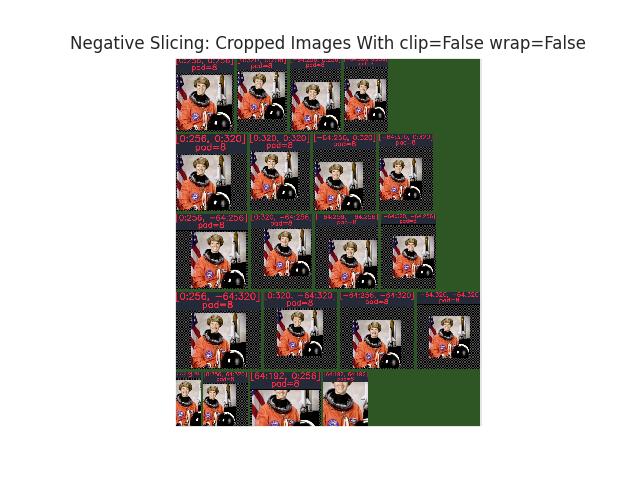
- _padded_crop(space_slice, pad=0)[source]¶
Does the type of padded crop we want, but inefficiently using a warp. Reimplementing would be good, but this is good enough for now.
- warp(transform, dsize='auto', **warp_kwargs)[source]¶
Applys an affine transformation to the image. See
DelayedWarp.- Parameters:
transform (ndarray | dict | kwimage.Affine) – a coercable affine matrix. See
kwimage.Affinefor details on what can be coerced.dsize (Tuple[int, int] | str) – The width / height of the output canvas. If ‘auto’, dsize is computed such that the positive coordinates of the warped image will fit in the new canvas. In this case, any pixel that maps to a negative coordinate will be clipped. This has the property that the input transformation is not modified.
antialias (bool) – if True determines if the transform is downsampling and applies antialiasing via gaussian a blur. Defaults to False
interpolation (str) – interpolation code or cv2 integer. Interpolation codes are linear, nearest, cubic, lancsoz, and area. Defaults to “linear”.
border_value (int | float | str) – if auto will be nan for float and 0 for int.
noop_eps (float) – This is the tolerance for optimizing a warp away. If the transform has all of its decomposed parameters (i.e. scale, rotation, translation, shear) less than this value, the warp node can be optimized away. Defaults to 0.
- Returns:
DelayedImage
- dequantize(quantization)[source]¶
Rescales image intensities from int to floats.
- Parameters:
quantization (Dict[str, Any]) – quantization information dictionary to undo. see
delayed_image.helpers.dequantize()Expected keys are: orig_dtype (str) orig_min (float) orig_max (float) quant_min (float) quant_max (float) nodata (None | int)- Returns:
DelayedDequantize
Example
>>> from delayed_image.delayed_leafs import DelayedLoad >>> self = DelayedLoad.demo().prepare() >>> quantization = { >>> 'orig_dtype': 'float32', >>> 'orig_min': 0, >>> 'orig_max': 1, >>> 'quant_min': 0, >>> 'quant_max': 255, >>> 'nodata': None, >>> } >>> new = self.dequantize(quantization) >>> assert self.finalize().max() > 1 >>> assert new.finalize().max() <= 1
- get_overview(overview)[source]¶
Downsamples an image by a factor of two.
- Parameters:
overview (int) – the overview to use (assuming it exists)
- Returns:
DelayedOverview
- get_transform_from(src)[source]¶
Find a transform from a given node (src) to this node (self / dst).
Given two delayed images src and dst that share a common leaf, find the transform from src to dst.
- Parameters:
src (DelayedOperation) – the other view to get a transform to. This must share a leaf with self (which is the dst).
- Returns:
The transform that warps the space of src to the space of self.
- Return type:
Example
>>> from delayed_image import * # NOQA >>> from delayed_image.delayed_leafs import DelayedLoad >>> base = DelayedLoad.demo().prepare() >>> src = base.scale(2) >>> dst = src.warp({'scale': 4, 'offset': (3, 5)}) >>> transform = dst.get_transform_from(src) >>> tf = transform.decompose() >>> assert tf['scale'] == (4, 4) >>> assert tf['offset'] == (3, 5)
Example
>>> from delayed_image import demo >>> self = demo.non_aligned_leafs() >>> leaf = list(self._leaf_paths())[0][0] >>> tf1 = self.get_transform_from(leaf) >>> tf2 = leaf.get_transform_from(self) >>> np.allclose(np.linalg.inv(tf2), tf1)